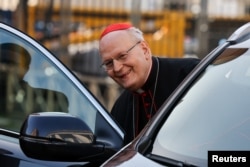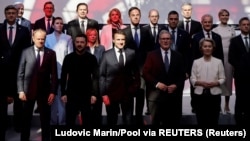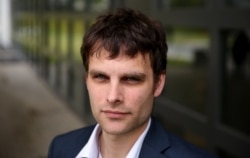
Welcome to Wider Europe, RFE/RL's newsletter focusing on the key issues concerning the European Union, NATO, and other institutions and their relationships with the Western Balkans and Europe's Eastern neighborhoods.
I'm RFE/RL Europe Editor Rikard Jozwiak, and this week I am drilling down on two issues: the European game plan for the Ukraine-Russia talks, and whether the next pope will be Hungarian.
Briefing #1: What's Europe's Game Plan For Ukraine-Russia Peace Talks?
What You Need To Know: Over the past week, European nations largely represented by France, Germany, and the United Kingdom have tried their best to engage in talks between the United States, Ukraine, and Russia. There were a number of rather successful high-level meetings in Paris on April 17 and one in London six days later that ended up being politically downgraded after Secretary of State Marco Rubio and special envoy Steve Witkoff pulled out. The snub reportedly came over Kyiv's unwillingness to agree to a peace plan involving the recognition of Russia's illegal annexation of the Crimean Peninsula.
After speaking with several European diplomats familiar with the matter, it's clear that something of a game plan has emerged in response. The first priority is keeping the Americans onboard and keeping them talking to the Ukrainians. Exactly how successful this aim can be is up in the air, as Washington has threatened to walk away if no progress is made soon. The officials I talked to, however, believe this could be a negotiation tactic aimed to pressure Ukraine, saying Trump has a penchant for playing tough in public only to go back to the negotiation table later -- as evidenced by the way he has enacted and retracted sweeping trade tariffs in recent weeks.
Deep Background: The Europeans are keen to secure what they call a "sequencing," meaning first a cease-fire observed by both sides followed by lasting peace. The belief is that this could ensure more of Ukraine's security interests are guaranteed and that not everything is on Moscow’s terms. There is hope that Ukraine's willingness to observe a cease-fire in the past month -- and Russia's failure to do so -- shows that Kyiv is acting in good faith and not Moscow. This would also buy the Europeans time to assemble a "reassurance force" in the Western part of Ukraine with at least some sort of American political backing, even though American participation seems off the table, according to the European diplomats I spoke with. The current thinking is less of a "boots on the ground" presence and more toward air patrolling with the aim of securing Lviv airport and the surrounding areas as a transport hub for Ukraine. The Europeans are also keen to continue military aid to the country. Although there is an understanding that it might be impossible to completely fill the void left by the United States, there's hope that European money will keep flowing and the new German government in place in early May will be more forthcoming, notably on providing Kyiv with long-awaited Taurus cruise missiles.
Drilling Down
• As for some of America's demands for a potential peace proposal, the Europeans are also crystal-clear. There will never be a de jure recognition of Crimea as part of Russia -- unless, of course, Ukraine agrees to it. De facto recognition of the lands currently under Russian control is another matter. Ukrainian NATO membership being off the table can also be swallowed.
• Several European states hid behind the United States when, under the Biden administration, it nixed the prospects of inviting Ukraine into the military alliance at both the NATO summit in Vilnius in 2023 and in Washington a year later.
• Eventual EU membership, though, is another matter. Brussels and all key European capitals are adamant Moscow has no say in that. According to diplomats familiar with the proposed American peace deal, Russia accepts that Ukraine could join the bloc.
• A so-called Cyprus scenario, which means all of Ukraine could at some point be considered part of the club whereas in fact only those parts under Kyiv's control would be, is the most likely solution.
• One thing that appears off the table for now, to much European relief, is the call for new elections in Ukraine, a point that diplomats told me has quietly disappeared from American talking points after it was initially mentioned as a potential condition. I have heard that Russia still might want to push for it.
• Then there are the sanctions. While the United States has offered Russia sanctions relief, the Europeans are not in favor. You would need unanimity to lift the measures now, and that unanimity simply doesn't exist.
• In fact, I was told Paris and Berlin want to pile up pressure on Russia and, in particular, enact more restrictive measures in the coming weeks.A 17th round of restrictive measures against the Kremlin was in the works already after the deadly Russian attacks on the Ukrainian cities of Sumy and Kryviy Rih earlier in April, and Brussels will now speed up those efforts.
• The EU is also finalizing asset freezes and visa bans against 15 Russians accused of carrying out hybrid attacks on the EU in a separate sanctions package. As with all things related to Russia, EU officials admit it will be hard to get Hungary to give the green light and that is why the next package is likely to be symbolic rather than hard-hitting.
• They also need to secure Budapest's consent to roll over sectoral sanctions on Russia in July. There are plenty of worries that this won’t happen and that even other member states will start picking out sanctions measures they don't like, hence the scrambling for alternatives to keep the sanction measures alive.
• The one item that most countries want to save are the near 200 billion euros of frozen Russian assets in the bloc, not least of all because the EU would like to use this sum as a bargaining chip against Moscow to pay for the reconstruction of Ukraine.
• The windfall profits from frozen assets currently bankrolls Ukraine's military needs, and the 45 billion euro G7 loan propping up Kyiv's macrofinancial needs for 2025 is backed up using frozen assets as a collateral. So Europe will want to sustain at least some sanctions on Russia going forward.
Briefing #2: Will Pope Francis's Successor Be Hungarian?
What You Need To Know: With the passing of Pope Francis on April 21, the speculation about who will succeed him as head of the Holy See is already in full swing. One of the front-runners, at least according to bookmakers, is Peter Erdo, the archbishop of Esztergom-Budapest. The 72-year-old Hungarian cardinal has held several prominent roles within the Catholic Church in recent decades and was a potential candidate to become the bishop of Rome already back in 2013, when Francis ultimately was chosen.
So what chances does Erdo have to replace the Argentine? And perhaps more interestingly, what is his relationship with Hungary's increasingly authoritarian conservative prime minister, Viktor Orban?
Make no mistake about it, Erdo is very much "papabile" -- a term used for candidates who are regarded as viable for the papacy. Technically any baptized Catholic male is eligible, but ever since the 14th century only cardinals, the senior members of the clergy, have been selected. Currently there are 252 cardinals, but that number dwindles to 135 with voting power, as only those under 80 can cast a ballot. Erdo could manage to secure the necessary two-thirds of the vote at the Papal Conclave that is set to commence in early May (no earlier than 16 days after the pope's passing, according to the current rules).
Deep Background: His cardinal resume is glittering. Between 2006 and 2016 he headed the Council of European Episcopal Conferences, a key organization representing Europe's Catholic bishops. This is not without significance, as European cardinals still form the biggest voting bloc in the upcoming conclave. But it's not only the European credentials he has honed. Heading the council meant that he has been in regular contact with the African, Asian, and Latin American equivalences, building up lots of links with the Global South, seen as the emerging powerhouses of the church. The fact that he is fluent in both Italian and Latin -- two crucial languages for higher offices in this part of Rome -- and is a recognized expert in canonical law, which governs the way the Catholic Church is run, also gives him good stead among a select few. Perhaps his crowning achievement is to have secured the International Eucharistic Congress for his hometown, Budapest, in 2021. The congress, which typically takes place every four years, is a massive gathering of both clergy, including the Pope, as well as common practitioners and involves big open-air masses. This provided him with a perfect platform both for visibility and to secure the necessary contacts both within the Vatican and across the Catholic parishes of the world. Perhaps his biggest strength, though, and the reason he might prevail in the end, is his pragmatism. Although Erdo is seen as a conservative who, for example, openly speaks out against divorced Catholics receiving holy communion, he cooperated with the more progressive Francis and refrained from criticizing him openly, unlike others on the traditionalist flank. The pope even tapped him to help organize special Vatican meetings on family issues, and Francis visited Hungary twice during his 12-year tenure.
Drilling Down:
• But what about Erdo's links to Hungary's ruling Fidesz party and Orban, who styles himself as a defender of Judeo-Christian values, notably against the EU institutions he claims are against both nations and Christianity in general?
• The Hungarian state budget sponsors the Catholic Church, like many other recognized churches, in various ways and generously. It notably does this through direct support via financing of religious education, paying reparations for assets seized during the Communist regime, or simply bankrolling events like the above-mentioned International Eucharistic Congress.
• Politically, during the migrant crisis that swept Europe in 2015, Erdo likened accepting migrants to facilitating human trafficking. It was a statement that seemed more in line with the Hungarian prime minister's more combative approach than that of Pope Francis's more tolerant view on the matter.
• Erdo did, however, shortly thereafter warn about turning religions against each other and questioned whether a continent really can be called Christian -- seemingly going against Orban's outspokenness about the so-called Islamization of Europe.
• He seems to take the same pragmatic approach to the Hungarian government as he has with the various factions of the Catholic Church. While he himself has never openly endorsed the party, Catholic priests across the country have often told their congregations to vote for Fidesz.
• Erdo has picked his fights carefully with Budapest. He has remained silent over some laws adopted in recent years but been vocal on others. For example, he refused to openly criticize the regulation against homelessness passed in 2018 -- an issue that went against the teachings of Pope Francis. When it came to the move by the Hungarian government to nationalize IVF clinics a year later, he did not hold out on criticism.
• While most Vatican watchers still believe the Catholic Church now might select its first-ever African or Asian pope, a compromise candidate to stabilize the various fractions after the progressive and tumultuous years of Francis might very well be the primate of Hungary.
Looking Ahead
There is an interesting case to be settled at the European Court of Justice on April 30 pertaining to the EU’s sanctions on Russia. The bloc has imposed restrictions on exporting banknotes denominated in an official currency of any EU member state even though there are exemptions for personal use. A regional court in Frankfurt has brought up a case in which a woman travelling from city’s airport to Moscow via Istanbul with nearly 15,000 euro was stopped and most of the money seized. The woman claimed the money was for various medical treatments she was planning to do in Russia and the court will now have to determine who wide the sanctions scope really is in this case.
That's all for this week!
Feel free to reach out to me on any of these issues on Twitter @RikardJozwiak, or on e-mail at jozwiakr@rferl.org.
Until next time,
Rikard Jozwiak
If you enjoyed this briefing and don't want to miss the next edition subscribe here.







